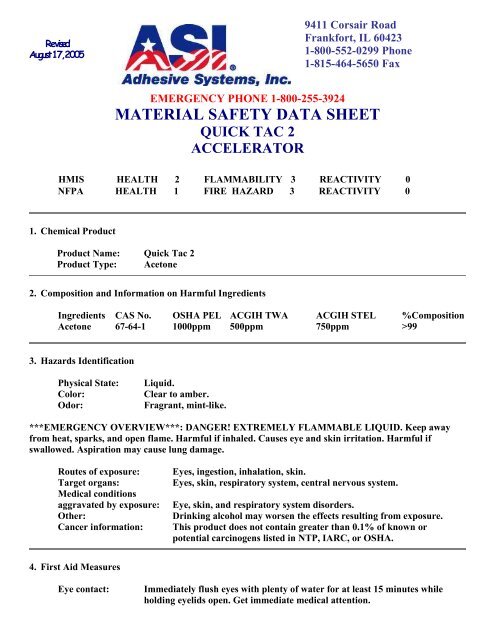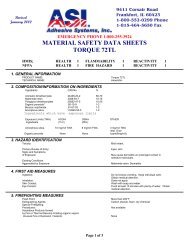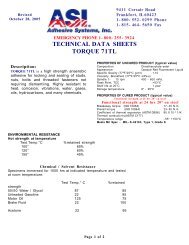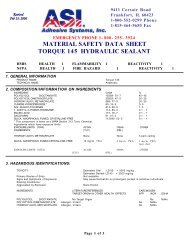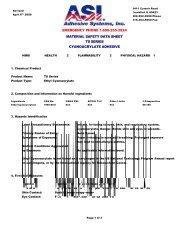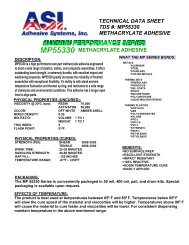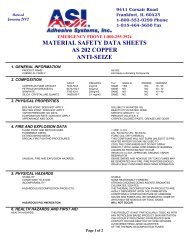MSDS - Regal Plastics
MSDS - Regal Plastics
MSDS - Regal Plastics
You also want an ePaper? Increase the reach of your titles
YUMPU automatically turns print PDFs into web optimized ePapers that Google loves.
Revised<br />
August17,2005<br />
9411 Corsair Road<br />
Frankfort, IL 60423<br />
1-800-552-0299 Phone<br />
1-815-464-5650 Fax<br />
EMERGENCY PHONE 1-800-255-3924<br />
MATERIAL SAFETY DATA SHEET<br />
QUICK TAC 2<br />
ACCELERATOR<br />
HMIS HEALTH 2 FLAMMABILITY 3 REACTIVITY 0<br />
NFPA HEALTH 1 FIRE HAZARD 3 REACTIVITY 0<br />
1. Chemical Product<br />
Product Name: Quick Tac 2<br />
Product Type: Acetone<br />
2. Composition and Information on Harmful Ingredients<br />
Ingredients CAS No. OSHA PEL ACGIH TWA ACGIH STEL %Composition<br />
Acetone 67-64-1 1000ppm 500ppm 750ppm >99<br />
3. Hazards Identification<br />
Physical State:<br />
Color:<br />
Odor:<br />
Liquid.<br />
Clear to amber.<br />
Fragrant, mint-like.<br />
***EMERGENCY OVERVIEW***: DANGER! EXTREMELY FLAMMABLE LIQUID. Keep away<br />
from heat, sparks, and open flame. Harmful if inhaled. Causes eye and skin irritation. Harmful if<br />
swallowed. Aspiration may cause lung damage.<br />
Routes of exposure:<br />
Target organs:<br />
Medical conditions<br />
aggravated by exposure:<br />
Other:<br />
Cancer information:<br />
Eyes, ingestion, inhalation, skin.<br />
Eyes, skin, respiratory system, central nervous system.<br />
Eye, skin, and respiratory system disorders.<br />
Drinking alcohol may worsen the effects resulting from exposure.<br />
This product does not contain greater than 0.1% of known or<br />
potential carcinogens listed in NTP, IARC, or OSHA.<br />
4. First Aid Measures<br />
Eye contact:<br />
Immediately flush eyes with plenty of water for at least 15 minutes while<br />
holding eyelids open. Get immediate medical attention.
MATERIAL SAFETY DATA SHEET<br />
QUICK TAC 2<br />
ACCELERATOR<br />
Skin contact: Flush skin with plenty of water while removing contaminated clothing and<br />
shoes. If irritation persists, get medical attention.<br />
Inhalation: Remove to fresh air. If breathing is difficult, administer oxygen. If not<br />
breathing, give artificial respiration, preferably mouth-to-mouth. GET<br />
MEDICAL ATTENTION IMMEDIATELY.<br />
Ingestion: If swallowed, call a physician immediately. DO NOT induce vomiting unless<br />
directed to do so by a physician. If vomiting occurs spontaneously, keep head<br />
below hips to prevent aspiration of liquid into the lungs.<br />
NOTE TO PHYSICIANS: There is no specific antidote. Treatment should be directed at<br />
controlling symptoms and the clinical condition of the patient. Any material aspirated during<br />
vomiting may cause lung injury. Therefore, emesis should not be induced mechanically or<br />
pharmacologically. If it is necessary to evacuate the stomach contents, this should be done by<br />
means least likely to cause aspiration (e.g., gastric lavage after endotracheal intubation).<br />
5. Fire Fighting Measures<br />
Flash Point: < 0°F<br />
Flammability Limits: LEL: 1.5% UEL: 13%<br />
Autoignition temperature: 869°F<br />
Extinguishing Media:<br />
Water spray, foam, dry chemical or CO2.<br />
Special Fire Fighting Procedures:<br />
Wear self contained breathing apparatus.<br />
Fire / Explosion Hazards:<br />
EXTREMELY FLAMMABLE LIQUID. Vapors<br />
are heavier than air.<br />
Hazardous Thermal Decomposition Products: Carbon dioxide, carbon monoxide.<br />
6. Accidental Release Measures<br />
EXTREMELY FLAMMABLE LIQUID. Eliminate all sources of ignition. Evacuate unprotected<br />
personnel from area. Maintain adequate ventilation. Follow personal protection recommendations<br />
found in section 8. Shut off source of leak if safe to do so. Use non-sparking tools and equipment.<br />
Contain spill, place into drums for proper disposal. Soak up residue with non-flammable<br />
absorbent material. DO NOT use sawdust. Avoid direct discharge to sewers and surface waters.<br />
Notify authorities if entry occurs. Use water spray to control vapor.<br />
7. Handling and Storage<br />
Storage:<br />
Handling:<br />
EXTREMELY FLAMMABLE LIQUID. Store in a cool, well-ventilated area away<br />
from all sources of ignition and out of direct sunlight. Keep containers tightly closed.<br />
Bond and ground transfer containers and equipment.<br />
Avoid contact with eyes, skin, and clothing. DO NOT PRESSURIZE, CUT, WELD,<br />
BRAZE, SOLDER, DRILL, GRIND, OR EXPOSE CONTAINERS TO HEAT,<br />
FLAME, SPARKS, STATIC ELECTRICITY, OR OTHER SOURCES OF<br />
IGNITION. THEY MAY EXPLODE AND CAUSE INJURY OR DEATH.<br />
8. Exposure Control and Personal Protection<br />
Engineering controls:<br />
Engineering controls are imperative when using this product to
MATERIAL SAFETY DATA SHEETS<br />
QUICK TAC 2<br />
ACCELERATOR<br />
Respiratory protection:<br />
Eye/face protection:<br />
Skin protection:<br />
Other protective equipment:<br />
General hygiene considerations:<br />
avoid overexposure. Do not use in closed or confined spaces.<br />
If exposure limits are exceeded, wear NIOSH respirator.<br />
Wear chemical safety goggles and a full face shield.<br />
Prevent contact. Wear gloves made of butyl rubber, neoprene,<br />
natural rubber, nitrile, viton®, polyvinyl alcohol, polyethylene,<br />
or polyvinyl chloride.<br />
Eye-wash station, safety shower, rubber apron.<br />
Wash with soap and water before meal times and at the end of<br />
each work shift.<br />
9. Physical and Chemical Properties<br />
Boiling point: 133°F Specific gravity: 0.79@20°C<br />
Freezing point: -139°F % Volatile: 100<br />
Melting point: N.A. Evaporation rate: >5<br />
Vapor pressure: 180@20°C VOC (WT%): 0<br />
Solubility in water: Complete VOC (Lbs/Gal): 0<br />
10. Reactivity and Stability<br />
Stability:<br />
Hazardous Polymerization:<br />
Incompatibility:<br />
Conditions to Avoid:<br />
Hazardous Decomposition Products:<br />
Stable.<br />
Will not occur.<br />
Acids, alkalies, ozidizers.<br />
Avoid contact with heat, sparks, electric arcs, and open<br />
flames.<br />
Carbon dioxide and carbon monoxide.<br />
11. Toxicoligical Information<br />
Oral LD50:<br />
Dermal LD50:<br />
Inhalation LC50:<br />
Rat – 5800mg/kg<br />
Mouse – 3000mg/kg<br />
Rabbit – 20g/kg<br />
Rat – 50100mg/m³/8H<br />
LCLo mouse – 110g/m³/8H<br />
Development of cataracts has been reported in laboratory animals after prolonged or repeated<br />
exposure to acetone. In animal studies, repeated oral dosing of large amounts of acetone was<br />
reported to cause adverse effects in the hematological system, liver, kidney, and testis. In animals,<br />
acetone administration can potentiate the toxicity of a variety of chemical toxicants, which is<br />
believed to be secondary to induction of live enzymes. In pregnant animals exposed to high<br />
concentrations of acetone, there were no birth defects, but some evidence of embryofetal toxicity.<br />
12. Ecological Information<br />
Extensive data, call for information.
13. Disposal Considerations<br />
MATERIAL SAFETY DATA SHEETS<br />
QUICK TAC 2<br />
ACCELERATOR<br />
Hazardous waste number: U002; D001<br />
Note:<br />
When acetone is a spent solvent, it is classified as a hazardous waste<br />
from a nonspecific source (F003). An additional EPA hazardous<br />
waste number may include: D018<br />
Disposal method: Dispose of in a permitted hazardous waste management facility<br />
following all local, state, and federal regulations.<br />
14. Transportation Information (Not meant to be all inclusive)<br />
DOT (Department of Transportation):<br />
Shipping name:<br />
Acetone<br />
Hazard class: 3<br />
ID/UN number:<br />
UN1090<br />
Packing group:<br />
II<br />
Label required:<br />
Flammable Liquid<br />
Reportable quantity (RQ): 5000Lbs.<br />
15. Regulatory Information<br />
State requlations:<br />
California – The following components are listed under Prop 65:<br />
Benzene (


